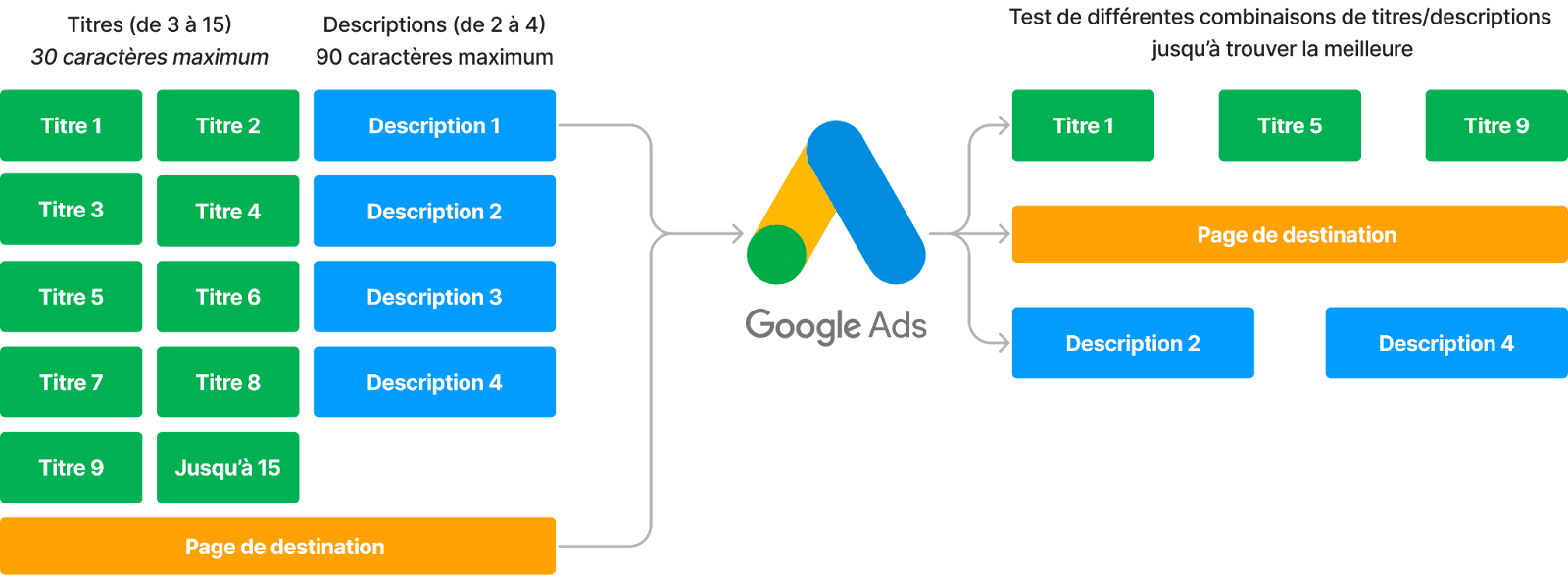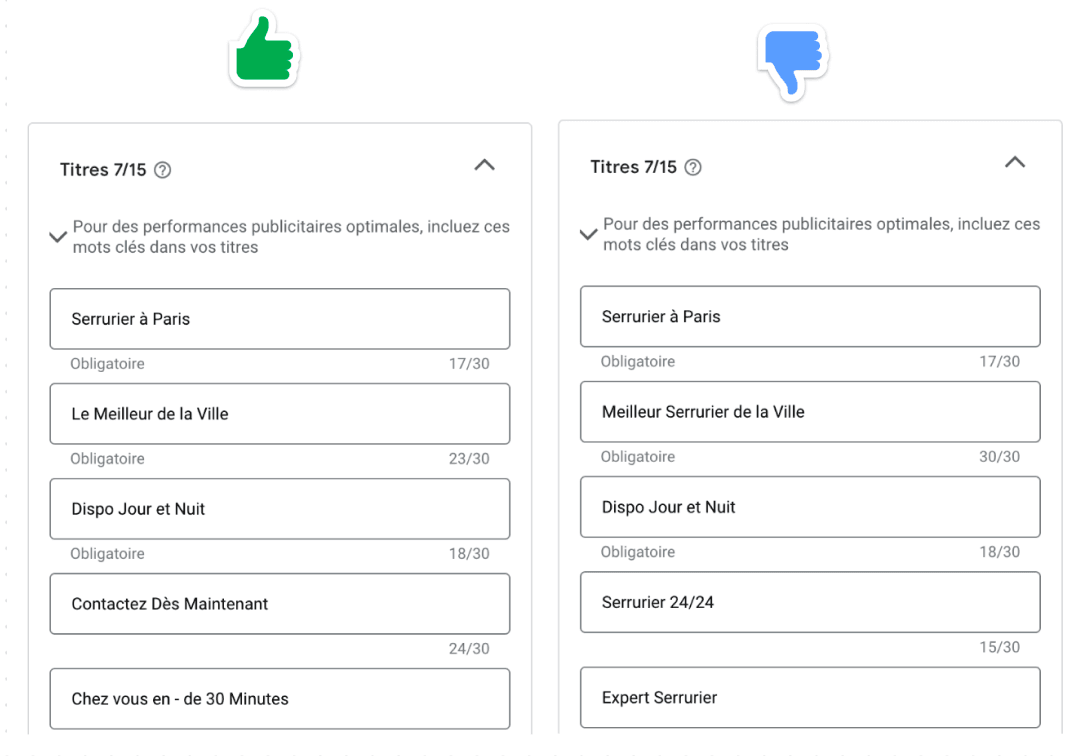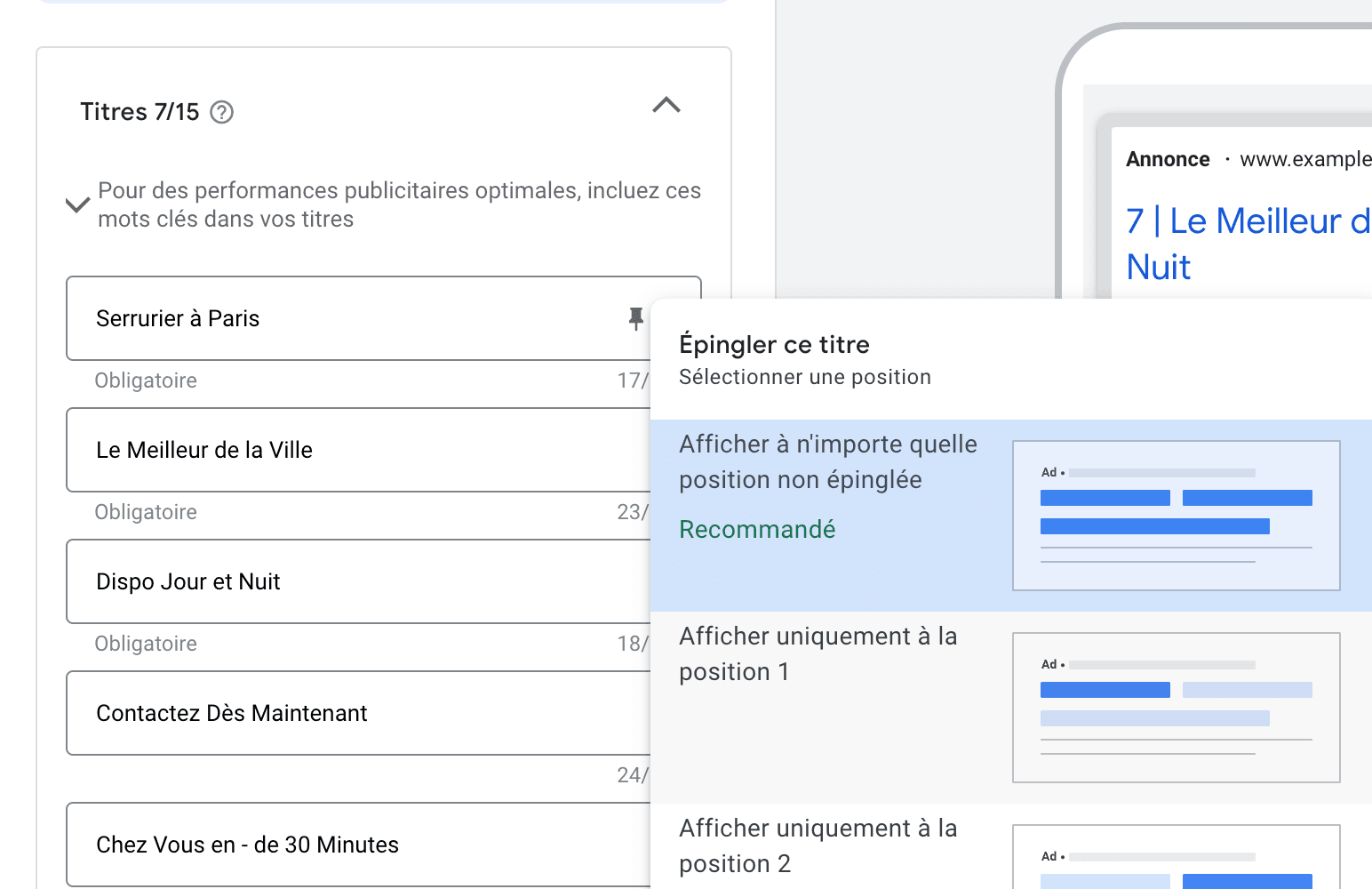Notre site dispose désormais d'un mode éco. N'hésitez pas à l'essayer !
Google ended text ads (ETAs) on June 30, 2022 to highlight its new product: RSA (Responsive Search Ads).
Historically, we could have 3 titles, 2 descriptions, 2 paths to display and 1 url to display, thus limiting the "creative" aspect but maximizing the control over the message we wanted to highlight to users. From now on, it is impossible to create this type of ads when you set up a google ads campaign and the only choice available to you is the responsive ad (otherwise known as RSA). This format uses human creativity and machine learning to provide the best combination of titles and descriptions for your users. Of course, you are still responsible for finding titles and descriptions related to your business, following certain rules such as including the keyword(s) present in the ad group using your RSA. It is often said that a picture is worth a thousand words, so here is a diagram representation of how an RSA is composed:

The main advantage of RSAs is that they can test multiple titles and descriptions with a single ad. There is therefore no need to create several ads, and compare them and wait a certain amount of time to decide if ad A performs better than ad B. Google will test several combinations over a period of time and depending on the results, the algorithm will decide to display the combination of "winning" titles and descriptions more often.
About the results... RSAs tend to have a higher click-through rate (5-15% higher on average) compared to Google's enlarged text ads. However, this information should be taken with a pinch of salt, why? Simply because averages tend to lie. Indeed, not all advertisers will benefit the same from getting more clicks and a click is not necessarily a vector of results in your traffic acquisition strategy.
Finally, if you don't have an above-average click-through rate, it's not uncommon for the conversion rate and cost per conversion to be higher if you compare the performance of an RSA and a text ad already in your account, which is not "abnormal" given that the algorithm tries to attract as many clicks and conversions as possible. It is therefore important to understand and implement certain "best practices" in order to get the most out of RSAs.
How to Set Up an RSA and What Are the Best Practices? In order to put an RSA online, you must have at minimum 3 headlines and 2 descriptions. While you could stop there, the bare minimum is rarely the best solution.
You can start by using elements from your best text ads to create your first RSA (if you have historical data in your Google Ads account). However, if you don't have any data, here is how to proceed:
1) Highlight something different in each headline and description
Avoid repeating yourself in your headlines. A good RSA offers several unique messages that can be combined together.
On the left is a “good” example of ads, highlighting the main activity and the user's search intent (in the case that you are a locksmith in Paris, of course...) but also the competitive advantage, benefits, availability, etc.
On the right is a counter-example: too many repetitions of the keyword "locksmith," very few value propositions...

2) Vary the Length of Your Headlines and Descriptions
While it is always preferable to have headlines/descriptions reaching 30 or 90 characters to occupy as much space as possible, it is not necessary for all 15 of your headlines to be 30 characters long. Try to have shorter headlines to increase your chances of having a third headline displayed during an auction for one of your ads.
3) Use the Pinning Feature for Headlines and Descriptions
Google will automatically test certain headlines in different positions (1, 2, 3) to see how they perform individually, and the same goes for descriptions. This helps find the best message for each user, keyword, and device they are using for their searches.
However, if you have a specific message you always want to appear (for example, your brand name), you can pin it to the desired position.que) il est possible d’épingler ce dernier à la position souhaitée.

4) Pin, But Sparingly!
It is tempting to pin an important message in your ad, but this is not always the best thing to do.
Indeed, when you decide to pin a headline, it reduces the total number of headlines or descriptions that can match a potential user’s search, which can negatively impact your ad's performance. However, it is entirely possible to test this by creating two similar ads, one with a pinned headline and one without. It's worth noting that Google assigns a score to your ad as you create it, ranging from:
The goal is to achieve the best possible score, but don’t be blinded by it, as an “excellent” ad is not synonymous with a better click-through rate or conversion rate. We can explain this theory in more detail (and it will likely be the subject of a future article). In the meantime, here is an article from PPC Hero demonstrating the impact of ad effectiveness step by step.
5) Use the {Keyword} Tag
The {Keyword:} tag is a powerful feature in Google Ads, particularly useful for RSAs. It allows you to dynamically insert the keyword that triggered the ad directly into the ad text. This increases the relevance of the ad by exactly matching what the user searched for, which can improve click-through rates and ad quality.
How Does the {Keyword:} Tag Work?
Advantages of the {Keyword:}
By integrating the {Keyword:} tag into your RSAs, you can maximize the relevance and effectiveness of your ads, increasing the chances of achieving your conversion goals.
6) Use the Performance Combinations Report
Google provides a performance combinations report, allowing you to see how many impressions each combination of elements in your ad has received and which is the "best," or at least the one that has generated the most impressions. Of course, the number of impressions is not necessarily an indicator of performance, but it will give you an initial overview of which messages are predominantly displayed in your campaigns.
7) Best Practices are Good.. but
It is essential to understand that, despite the importance of best practices and technical optimizations in the creation and management of Google Ads campaigns, the core of our job remains marketing. This means we must always focus on creating powerful and convincing messages that resonate with our target audience.
To write ads that capture attention and drive action, I consistently use two fundamental frameworks: the AIDA model and Cialdini’s 7 principles of persuasion.
The AIDA model is a proven framework for structuring your marketing messages. It consists of four key steps:
The 7 Principles of Persuasion by Cialdini
Robert Cialdini identified seven principles of persuasion that can significantly enhance the effectiveness of your ads:
By integrating these frameworks into your ad writing, you can not only optimize your campaigns technically but also create powerful messages that attract, engage, and convert your prospects. Never losing sight of these fundamental principles is crucial for the long-term success of your marketing strategies.
You now know a bit more about responsive ads and are ready to integrate them into your campaigns. There are still some areas for optimization and possibilities, such as location insertion or countdowns, but these will be covered in a future article.